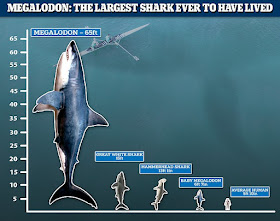 |
| AMNH pic |
For many of us, a summer afternoon is even better when an ocean is part of the picture too. But of course, oceans come with hazards way more serious than too many other people on the beach. For starters, think: sharks and other large marine creatures with variable attitudes toward humans.
And that suggests this question: which are you more scared of when you’re in the ocean: sharks or orcas (aka “killer whales”)? Or . . . (fill in the blank – if you can!) The answer will surprise you. https://tinyurl.com/4ym6x5nu
However, since sharks get the most “credit” for biting people, this clarification seems in order: Surprisingly enough, juvenile white sharks are responsible for most bites of humans, and that’s thought to happen because their eyesight is so comparatively bad, along with suspected color blindness! They can’t easily distinguish between “a swimming person, a paddling surfer or a meandering seal or sea lion.” https://tinyurl.com/yckncvht
However, if we were (admittedly very rare and short-lived) humans millions of years ago, we’d have a truly colossal reason to be terrified: megalodons, now described as “prehistoric megatooth sharks,” “the biggest sharks that ever lived” and “the biggest predatory fish of all time,” according to New York’s American Natural History Museum (amnh.org/exhibitions/sharks) and other sources.
But we’re lucky today to be able to see
enough of the fearful megalodon to feel a proper awe because the “Shark”
exhibition at AMNH for the next year includes “dozens of life-size models [of
ancient and modern sharks] ranging from 33 feet (you read it right!) to
5.5 inches long.” https://www.amnh.org/exhibitions/sharks
(don’t miss the short video) and https://tinyurl.com/3sckhw9u
The second site above reports new
findings based on 3-D computer modeling that suggest megalodons were in fact
even bigger, faster and hungrier than believed till now.
Two Princeton University researchers offer their take on megalodons in this video that provides the sea-setting for the prehistoric marine terrors – and a couple chuckles. https://tinyurl.com/2p82tmt5
Megalodon and shark fans in general still have more than a year to get to the museum for the shark exhibit. https://www.amnh.org/plan-your-visit
To the rescue of 4,000 beagles
Simply watch this video about beagles being rescued from a hideous laboratory situation (one of many such sites in the US) and fall in love. https://tinyurl.com/57bxth3x
Some 4,000 beagles – a breed widely
known for friendly and trusting animals – are being removed from the site,
tested and treated, and eventually adopted out to people eager to give them
love, a home and a chance to be beagles.
No longer are they living in cages and destined
to be subjects in animal experimentation. Till now, they had neither toys nor names –
just a number tattooed inside an ear – and no familiarity with sun, grass. . .
or love.
The Humane Society of the US was charged by the Dept. of Justice to free and care for the helpless dogs, with rescue
groups and shelters around the country joining the effort. Here are a few more links to some of those pitching
in on the rescue.
One warning: Be careful! After seeing such beagle videos, you may go
to great lengths to adopt one of these dear dogs!
#




Nice videos. I'm glad the megalodons aren't around anymore.
ReplyDelete